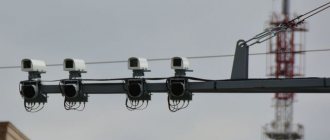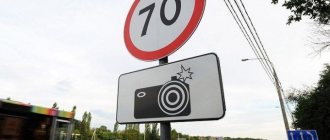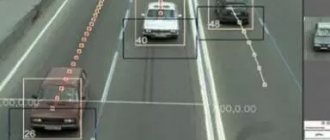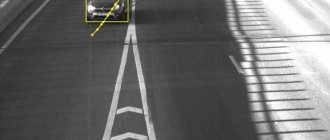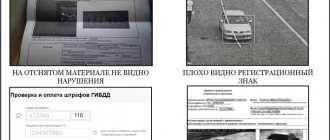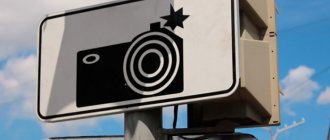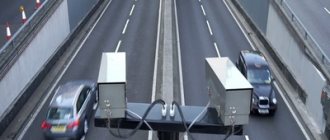Let's look into the issue
Despite existing fines and an increase in the number of cameras recording violations, drivers continue to systematically violate traffic rules. Only now, in addition to the usual protocol, “chain letters” are starting to arrive from cameras recording violations.
At the moment, the most fines are for exceeding the speed limit. The second place in terms of fines is occupied by violations related to non-compliance with the requirements of road signs and markings. Well, the top three is completed by fines for driving on the side of the road.
Quite recently, Channel One discussed the issue of car fines. I will say right away that I only watch news channels. And even then I try to find out all the changes via the Internet. So, in another news story they told where the paid fines go. And here's what I found out.
Private cameras: Whose pocket do we pay traffic fines into?
Summer residents are a tasty prey for licensed hunters of violators.
Photo: Ruslan VORONOY, Express newspaper
Do you think that only the state monitors compliance with traffic rules? You are wrong. Today, video recording systems installed by private owners have appeared on the roads.
ROCKING TO THE BUDGET
Cameras are not only a means of preventing road accidents, but also a source of hefty profits for regional budgets. Moscow received 16.6 billion rubles in 2021. Tatarstan - 3 billion. Moscow region - 2.4 billion.
This money remains entirely in the local treasury. It would seem like a goldmine - stick a camera at each turn, like an oil pump. But it costs about 2 million rubles. You also need to install it, connect it to the system, and maintain it. The regions have no money. But officials found a way out: they entrusted the installation of cameras to private companies, which receive money from each fine received.
HOW THE INCOME IS DIVIDED IN THE MOSCOW REGION
Since the beginning of this year, the number of cameras in the Moscow region has increased fivefold. The breakthrough was provided by the private sector, which installed 1011 stationary and 200 mobile fixation systems. The cost of the project is at least 2 billion rubles. Under the terms of the agreement, valid for 12 years, MVS Group will receive 233 rubles from each fine paid. commissions. From the 13th year, the equipment remains the property of the region, and the contractor ceases to receive royalties. How exactly the income will be distributed - see the “Numbers Only” chart.
In other regions, such as Tula, security cameras are owned by a bunch of small companies or even individual entrepreneurs. It is somewhat reminiscent of a fishing license: the right to install equipment is won in a competition, and the location of the trap is determined by the authorities.
EMERGENCY PLACES
Formally, cameras should be installed in areas with a high accident rate (from three accidents per year). But in reality they are stuck where they will collect more fines.
“On the Volokolamsk highway, from the concrete road to Dedovsk, I counted 14 cameras. It’s only 14 kilometers to go there,” Muscovite Ivan Starikov complained on social networks.
“I just returned from a trip Moscow - Sochi - Moscow. Be vigilant - there are dozens of private cameras on the highway, most of them in the section from Rostov-on-Don to Krasnodar,” Evgeny Maslov warned on Facebook.
The route from Moscow to Yaroslavl passes through the territory of three regions. In the Moscow region, the limit is 90, and there are cameras all over the place. In the Vladimir region, the limit is 110 (highway), and not a single camera, although the route is the same. In the Yaroslavl region, the width of the road drops from four to two lanes, the quality of the asphalt decreases, and the speed limit remains the same as in the Moscow region - 90. At the same time, according to traffic police statistics, the accident rate on the road in all three regions is approximately the same. That is, it’s not about speed and cameras.
“Private companies installing cameras can manipulate the rules to their advantage,” Petr Shkumatov, coordinator of the Blue Buckets automobile movement, told me. “It’s enough to stage three minor accidents yourself in the same place for it to fall into the category of emergency.” Then the officials allow a camera to be installed there, and the money starts rolling in.
Only numbers
Photo: Dmitry POLUKHIN
CAMERAS ARE NOT A PANACEA
Vladimir Putin gave the command: by 2024, the death rate on the roads should decrease by 3.5 times, and by 2030 it should reach zero. Officials took a stand and rushed to increase the number of cameras: if they couldn’t carry out the president’s command, at least the budget would be replenished.
However, the effectiveness of the cameras remains questionable.
“In places with low traffic intensity, after installing a video recording system, the number of violations decreases by 20 - 30% over time. And where the intensity is high and there is a lot of transit transport, the number of violations, as a rule, remains at the same level,” the Ministry of Transport of the Moscow Region told KP.
That is, on big roads, where people usually get fines, installing a camera has no effect! And in other places, 70% of drivers continue to violate laws even under cameras.
Video recording alone cannot reduce road deaths. Take Sweden's Vision Zero program. The greatest effect was achieved by the construction of “2+1” type roads. When the rows of lanes on a three-lane road alternate every few kilometers. The driver does not need to enter oncoming traffic to overtake - just wait for the expansion on his part.
Safe pedestrian crossings, marked not only by markings, but also by lighting and speed bumps, have reduced the accident rate by half.
WHAT’S IT LIKE IN MOSCOW?
The capital's cameras either belong to the city or are leased - the city spends money on their maintenance, but does not share fines with anyone. As Finexpertiza calculated, the capital’s budget receives 16.6 billion rubles from them per year. And according to the Center for Traffic Management, it spends only 1.5 billion rubles on maintenance. Net income: 15.1 billion rubles.
QUESTION - RIB
How much do we lose from road accidents?
There is no single methodology for assessing the value of human life. If we combine several theories, it turns out that the death of one adult Russian on the road costs society
10 million rubles (money for education, training, lost contribution to GDP, etc.).
In 2021, 19 thousand people died on the country's roads. This is a loss of 190 billion rubles. At the same time, drivers paid 70 billion rubles in fines for violating traffic rules.
What are the funds spent on?
As of 2021, the total amount of fines transferred to the budgets of the constituent entities of the Russian Federation amounted to 60 billion rubles. In 2019, the amount increased by another 7 billion.
Now all funds collected from motorists are used for road maintenance and repair. Previously, these amounts were spent on sudden needs. For example, it was necessary to close holes in the budget.
Representative of the Volgograd Regional Duma Mikhail Tarantsev decided to comment on the situation.
As the deputy says, maintaining cameras for recording violations would be much cheaper if the state were involved in this. Now everything is done by private traders. This is not surprising, because private partnership with the state is legal in our country.
This is how they work in almost all areas. The only exception is the Saratov region. There, the system for recording violations is entirely owned by the state. Local authorities refused to cooperate with private individuals.
“I would also like to talk about the interest that private owners charge from fines. They often reach up to 50% of the total fine. And if we consider the scale of the problem, it becomes clear that state-owned companies are much more profitable in this matter,” the deputy added.
To budgets of different levels
Distributing money between budgets is very complex. According to Article 46 of the Budget Code of the Russian Federation, fines established by the Code of Administrative Offenses of the Russian Federation (CAO RF) are subject to credit to the federal budget if decisions to impose administrative fines are made:
- federal court judges;
- officials of federal executive authorities, their structural divisions, territorial bodies and other federal government bodies;
- officials of the Central Bank of the Russian Federation;
- officials of state institutions subordinate to federal executive authorities.
Meanwhile, not all the money goes to the federal budget. Much more funds are allocated to the regional budgets of the constituent entities of the federation. For this purpose, the decision on enrollment must be made by regional authorities.
Can they be fined for instantaneous and average speed on the same section? More details
For example, the laws state that fines are subject to credit to the budgets of the constituent entities of the Russian Federation in the event that decisions on the imposition of administrative fines are made:
- officials of executive authorities of the constituent entities of the Russian Federation;
- officials of state institutions subordinate to the executive authorities of the constituent entities of the Russian Federation.
The collected money can also be distributed between budgets of different levels as a percentage. There are also laws about this.
Article on the topic
Penalty for fines. How will motorists be punished now?
Login to the site
I decided to share my way of dealing with the ubiquitous cameras.
I myself am from Kazan, but I’ve already moved to Moscow for half a year. In both cities, the traffic police installed so many cameras that it became simply impossible to drive normally. I think the situation in other cities is not much different. Previously, I didn’t pay any attention to the cameras, I thought they were hanging and hanging themselves, I won’t get caught by them. But the scam ended when I discovered several “chain letters” worth a significant amount in my mailbox. Of course, I had to pay fines. Where to go. ;(
After paying the fines, I tried to drive without breaking the speed limit, but it’s simply not possible! It's stupid to drive 60 km when the road is clear. As a result, I exceeded the speed limit a couple of times on an empty section of the road, where I thought there were no cameras. As a result, I received a new batch of fines. In general, I’m terribly tired of this whole situation with running from cameras and fines. I started scouring the Internet for tools to help me circumvent fines from cameras.
What are the means of protection against fines from cameras recording traffic violations?
1. Someone advises using an anti-radar; for the highway, yes, this is an ideal option, but in a city where cameras are installed every 800 meters, the meaning of this device is lost; you don’t even have time to accelerate from camera to camera.
2. I immediately dismissed inverted frames and curtain frames; in addition to the high cost, you also have to pay a considerable amount for their installation, and even if an inspector stops you, you can’t get away with it. Immediate deprivation of rights. It would be better to drive without license plates at all then. 
3. Polarizing pads and grids for numbers were also not suitable for my task. They are very pale, and their effect is questionable.
4. There was still hope for the Photoblocker miracle spray, but as it turned out, it didn’t work. Although it was created for the American market, perhaps their cameras work on a different principle.
5. The modern method - which I will tell you in more detail now.
Just when I was completely desperate, I found a website where they sell German film for number plates to protect against cameras. The film is black, cut out in the form of letters and numbers of Russian license plates. You just stick the film on the desired symbol and you’re good to go. ) This method is the most reliable and effective at the moment! It's the 21st century, technology has long advanced!
The operating principle of this miracle film is very simple: Most of the cameras installed on our roads are equipped with a regular or infrared flash. When the camera takes a picture, the film acts as a reflector and sends all the light from the flash back to the camera lens, resulting in the number being illuminated and not recognized by the camera.
Of course, there were doubts before the purchase, but I was won over by the free delivery and payment upon receipt after verification, and the ease of installation also played a significant role in choosing these stickers.
In general, I filled out an application on the website. After which a girl with a pleasant voice called , clarified the delivery address and answered all my questions. Within a few days, the courier delivered the order directly to the office. Naturally, before paying for everything, we decided to test these miracle stickers in action. We put the stickers on the table and took pictures with our iPhone. In the photo the numbers remain black. It turns out I forgot to turn on the flash on my phone))) With the flash on, the numbers turned from black to white. It's just some kind of fantasy. I took the photo again - indeed, the film works as it should! Satisfied with the test result, I paid the order to the courier and went to sculpt stickers for the number.
After which a girl with a pleasant voice called , clarified the delivery address and answered all my questions. Within a few days, the courier delivered the order directly to the office. Naturally, before paying for everything, we decided to test these miracle stickers in action. We put the stickers on the table and took pictures with our iPhone. In the photo the numbers remain black. It turns out I forgot to turn on the flash on my phone))) With the flash on, the numbers turned from black to white. It's just some kind of fantasy. I took the photo again - indeed, the film works as it should! Satisfied with the test result, I paid the order to the courier and went to sculpt stickers for the number.
For more reliable gluing, as the girl said, it was necessary to remove the number, wash it, degrease it, take it to a warm room and glue it there. I didn’t rent a room because I had anti-vandal frames installed, and the car was in a warm garage. I washed off the dust, moistened a cloth with vodka))) and wiped the entire license plate. Then I removed the paper backing from the film, applied the sticker to the number, smoothed it thoroughly and removed the transparent mounting film. I repeated the operation with other characters of my number. It turned out very well, the film on the number is not noticeable at all, and the entire process of installing the stickers took no more than 10 minutes. And yes, I almost forgot to make sure the stickers stick tightly by warming them up thoroughly with warm air from a hairdryer.
Now the most important thing remains - to check the stickers on the cameras. I began to drive as it was convenient for me, of course, within reason, but now I can afford to drive around sometimes without fear of fines from the cameras. 
I've been riding with film for a month and a half - during this time I received only one fine, and that was for an insignificant amount. In short, these stickers have paid for themselves more than once. Still, the Germans know how to do really worthwhile things.
the film on this site . The price of the film is equal to one exit per lane for public transport. Decide for yourself whether this is a lot or not, taking into account how many fines you receive.
Well, I hope this information was useful to you and you will stop receiving fines from cameras! Good luck to you!
Source: WORLD OF GIFTS Online
https://mirpodarkovonline.ru
Amount of traffic police fines for camera violations
The main task of video recording is to prevent speed violations of vehicles on emergency road sections.
A feature of the punishments recorded by the camera is the application of minimum fine rates, if the offense does not result in deprivation of a driver’s license - the maximum sanction is 5 thousand rubles. Amounts received from video recording cameras, in rubles:
- Art. 12.12 Code of Administrative Offences: driving through a red traffic light – 1000, leaving the stop line – 800.
- For violation of the established speed according to Art. 12.9 the sanction is differentiated. Clause 2: excess within the range of 20–40 km/h – 500; point 3 provides for a fine for 40–60 km/h from 1000 initially to 2000 for a repeated offense. Moving at a speed of 60–80, according to paragraph 4 of the same article. 12.9, for the first case you get 2500, for the second – 5000. Exceeding by more than 80 km/h entails a penalty of 5 thousand rubles. regardless of whether the rule is violated 1 or 2 times.
- For the lack of MTPL insurance, fines will begin from 03/01/2019 under Art. 12.37 – from 500 to 800 rub.
- According to Art. On 12.15 the fine for crossing a solid marking line comes - 1000-1500, and crossing a double line will cost 5000 rubles.
- Driving under a brick is punishable by 300 rubles, unless it is in oncoming traffic, when the penalty is already 5 thousand rubles.
Reference: in total there are a dozen and a half violations recorded using technical means. This spring, video fines will be introduced for driving into a busy intersection.
